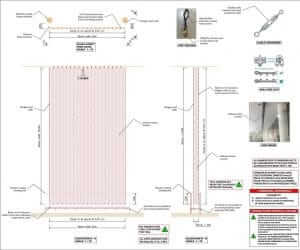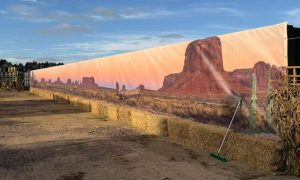The mural facade wrap at BNP Paribas in London is the second phase of the lifts maintenance. Similar to the mural facade wrap we produced for the front atrium lifts (link here) this installation process was similar. However as this mural facade wrap was only going to be fixed from the top of the fourth floor it was going to be a lot lighter. PVC banner material is approximately 500g to 600g per meter 2, making our facade wrap around 100kg.
Once again design calculations have to be carried out by specialist engineers to ensure the installation method would actually work and be safe.
Mural facade wrap excellent for covering construction or maintenance work
Working from the design, we attached dropper steel cables from the maintenance cradle track in the ceiling. We fixed using Pro Traxion pulleys to raise the mural facade wrap into location and lock into position. Then fixing the perimeter steel cables to the temporary floating hoarding on the ground floor. As the temporary hoarding was just freestanding we added 10 sand bags weighing 20kg each to increase the overall weight of the hoarding. The overall size of the printed mural was 17m high x 11m wide with two 600mm returns.
The same artwork design from the front lifts was used on these two lifts to save on costs.

Working on a Saturday the specialist rope access crew managed to install the facade wrap in just one day.
For more information on mural facade wrap or any large digitally print please contact Project Print Management, specialists in the more challenging Print Project. For our latest work please visit our blog page.
For information on our other project for BNP please visit here.

In architecture, the facade of a building is often the most important aspect from a design standpoint, as it sets the tone for the rest of the building. From the engineering perspective of a building, the facade is also of great importance due to its impact on energy efficiency. For historical facades, many local zoning regulations or other laws greatly restrict or even forbid their alteration.





